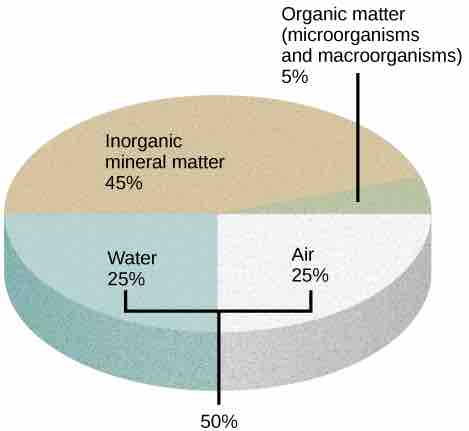Soil Composition
Plants obtain inorganic elements from the soil, which serves as a natural medium for land plants. Soil is the outer, loose layer that covers the surface of Earth. Soil quality, a major determinant, along with climate, of plant distribution and growth, depends not only on the chemical composition of the soil, but also the topography (regional surface features) and the presence of living organisms.
Soil consists of these major components :

Components of soil
The four major components of soil are shown: inorganic minerals, organic matter, water, and air.
- inorganic mineral matter, about 40 to 45 percent of the soil volume
- organic matter, about 5 percent of the soil volume
- water, about 25 percent of the soil volume
- air, about 25 percent of the soil volume
The amount of each of the four major components of soil depends on the quantity of vegetation, soil compaction, and water present in the soil. A good, healthy soil has sufficient air, water, minerals, and organic material to promote and sustain plant life.
The organic material of soil, called humus, is made up of microorganisms (dead and alive), and dead animals and plants in varying stages of decay. Humus improves soil structure, providing plants with water and minerals. The inorganic material of soil is composed of rock, slowly broken down into smaller particles that vary in size. Soil particles that are 0.1 to 2 mm in diameter are sand. Soil particles between 0.002 and 0.1 mm are called silt, and even smaller particles, less than 0.002 mm in diameter, are called clay. Some soils have no dominant particle size, containing a mixture of sand, silt, and humus; these soils are called loams.